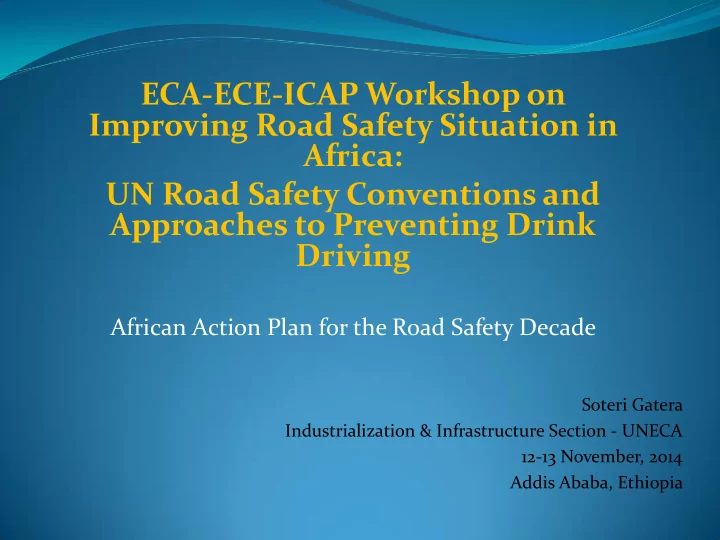

ECA-ECE-ICAP Workshop on Improving Road Safety Situation in Africa: UN Road Safety Conventions and Approaches to Preventing Drink Driving African Action Plan for the Road Safety Decade Soteri Gatera Industrialization & Infrastructure Section - UNECA 12-13 November, 2014 Addis Ababa, Ethiopia
Overview Introduction UN Decade Plan of Action for Road Safety 2011-2020 African Action Plan for the Road Safety Decade African Position Africa’s Specificities Policy Issues African Road Safety Charter Way forward 2
Introduction: Road Safety Situation Road Crashes is an issue of global concern; By 2050 the International Futures (IFs) forecasting model anticipates that global traffic deaths will surpass 3 million people per year; Africa stands at 9 % of world total road accident deaths & numbers are increasing (IRF World Road Statistics, 2012); The problem differ in extent and mix from one country to the next but their characteristics are common. Source: The Frederick Pardee Center for International Futures (www.ifs.du.edu )
Road Safety Situation……… Worldwide vehicle ownership is forecast to double by 2020 ( WHO, 2009); Much of this growth will be in emerging markets; Africa has experienced the highest urban growth during the last two decades at 3.5% per year; Road traffic injuries cost countries 1 – 3% of GDP; Only 15% of countries have comprehensive laws which address five key behavioral risks (drink- driving, over speeding, fatigue, not wearing seatbelt...) 4
Launching: the Decade of Action for Road Safety across the globe On 11 May 2011, the first ever Decade of Action for Road Safety – with the official goal to stabilize & then reduce crashes Mandated by the UN General Assembly Resolution (64/255); It is a collective roadmap indicating critical areas for engagement : improving the safety of roads and vehicles; enhancing emergency services; and building up road safety management in general. Creates the political platform needed to scale up some well- defined measures; Taking inspiration from the Global Plan, many countries have developed national plans for the Decade; and, A number of countries used the occasion of the Decade launch to revise existing or adopt new road safety legislation.
UN- Decade of Action Coordinated by the WHO, through the UN Road Safety Collaboration: governments, UN agencies, multilateral institutions and NGOs ; The Decade is a historic opportunity for countries to stop and reverse the trend which – without action – would lead to the loss of around 1.9 million lives on the roads each year by 2020; Organized around the 5 pillars of the ‘ Safe System ’ approach. 6
UN- Decade of PoA …… Road safety Safer roads and Safer Safer road Post-crash management mobility vehicles users response 7
African Position Significant reflections have taken place to improve road safety in Africa; Clear articulation of African position across the aboard: African Ministerial Declaration on Transport & MDGs (April, 2005) Accra Conference ( Feb, 2007) Dar es Salaam Workshop ( July, 2009) Addis Ababa Conference (Nov, 2011) The Second Meeting of the Conference of African Ministers responsible for Transport (Dec, 2011) 8
African Action Plan: Africa’s Specificities Global PoA does not address the specificities of the regions; therefore, there is a need to have a harmonized Plan of Action for Africa; Reduce road traffic crashes by 50% by the year 2020; Additional to the categories or “5 pillars " of activities, cross-cutting issues are included to address the African Rural Transport Safety; Evaluation of the Decade : mid-term (2015) & final Review; 9
Cont’d… APoA (Log frame): Expected Accomplishment, Activities, Monitoring Indicators, Main Actors; Time Frame : Expected Accomplishments ( derived from Accra Recommendation ) Activities/Actors/Time Frame (Addis Ababa Conference) Monitoring Indicators ( Dar es Salaam Workshop) 10
African Plan of Action……… Policy issues based on the six pillars 11
1. Road Safety Management Raising the profile of lead agency to high political offices Effective road safety management Development of road safety strategies Framework for financing road safety Better articulation of the roles and responsibilities of insurance companies Corporate social responsibility on road safety Alcohol manufactures (ICAP) Car manufactures Traffic accident data management – standardization and harmonization 12
2. Safer Roads Road safety audit – a requirement for road funding Axle loads control Axle load harmonization Standardization of road standards and signage Emphasis on road maintenance rather than new construction Dedication of a pre-identified proportion of cost to road safety User friendly designs – “a total road” approach 13
3. Safer Vehicles Safer Vehicles Importation, licensing, vehicle and inspection Certification of vehicle mechanics on road safety Control of usage of motor cycles 14
4. Safer Road Users Training and licensing of drivers Education curriculum on road safety Enforcement of existing laws and regulations 15
5. Post-Crash Better accident management Insurance scheme - mandatory third party liability and financing rehabilitation services 16
6. Cross-cutting issues Road safety audits on rural roads Sensitization of rural population on Road Safety Safety features in planning and construction of rural roads 17
African Road Safety Charter To serve as: a policy framework for Road Safety improvement in Africa; an advocacy tool and instrument for Road Safety improvement on the Continent aimed at facilitating the creation of an enabling environment to drastically reduce the road traffic crash. 3 rd AU Conference of Ministers of Transport, in Malabo, Equatorial Guinea, 10 th April 2014 (CAMT-III); The draft will be submitted for consideration at the next meeting of the Ministers of Justice (legal counsel).
Way Forward…. Carry out mid-term review in 2015: - Countries - Regional Economic Communities - Economic Commission for Africa - African Union Commission - African Development Bank
Thank you! 20
Recommend
More recommend